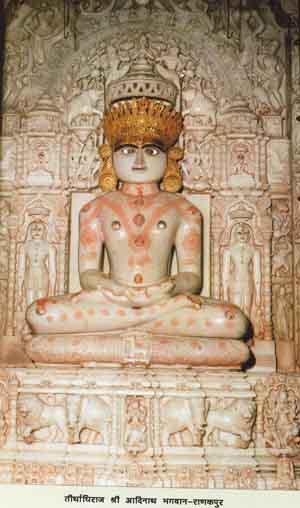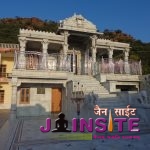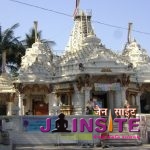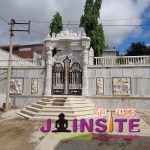SHRI RANAKPUR TIRTH
PRESIDING DEITY AND LOCATION :
Sri Adishvar Bhagwan in white color, seated in a lotus posture of height 180 Cms, located in a shrine in the bank of a small river named Maghai, flowing amidst the triple beauty of silence, stillness and solitude of the wilds, among the small hillocks of Aravalli mountains. (Shve).
ANTIQUITY AND SALIENT FEATURES :
The history of this shrine begins in Vikram year 1446. The construction of this temple was started in Vikram year 1446 by Sri Dharanashah minister of Rana Kumbha due ti the religious discourses he had from Yugpradhan Acharya Sri SOmsundersurishvarji. Fifty years later i.e. in Vikram year 1496, the consecration and sanctification ceremonies of the temple then referred to as “Dharan Vihar Mandir” (place-temple of Dharanashah abridged as “Dharan”), peaks of which touched the sky giving an appearance of a space-ship from heaven called “Nalinigulm Dev Viman” were also performed by him when a great festival of joy and ecstasy was attended by numerous people. Near the temple a large city was already founded which first was called Ranapur and later Ranakpur.
In Vikram year 1499 Poet Megh saw the temple himself and in a poetic composition made by himself entitled “Ranigpur Chatur Mukh Prasad” described this Ranakpur city as similar to Patan. At that time, there lived here three thousand affluent Jain house-holder families. Due to the discourses of Acharya Sri Hirvijaysurishvarji who was revered by Badshah Akbar, a hall called “Meghnad Mandap” was built here. This as well as the fact of repairs and renovations are mentioned in a reference that is available. In 18th Vikram century Sri Gnanvimalsuriji and Sri Samaysunder Upadhyayji in their devotional compositions have beautifully described this shrine. Poet Megh Ganivar has stated about the existence of seven temple here and Sri Gnan Vimalsuriji has stated about the existence of five temples. At present time, there are only three temples and no residence of any single Jain householder family. Once a large magnificent city of Ranakpur is now completely desolate. No history is available as to when this happened. It is however said that during the period of Aurangzeb, the muslim invaders may have caused here a heavy and devastating destruction. Many ruins are still visible in the surrounding high hills though the place stands in tact among them with dignity and majesty talking to the mountains reminful of the glories of the past centuries. The last repairs and renovations carried out here were in Virkam year 2009 by Anandji Kalyanji Pedhi founded by entire Jain community.
The special points of this shrine have also their dignified history. The chief credit for bringing this shrine into existence indeed goes to Yugpradhan Acharya Sri Somsunderjsuriji. At his inspiration, religious feelings sprouted and swelled up to the extent in the heart of Sri Dharnashah, minister of Rana Kumbha, a fortunate son of Sheth Kunvarpal and his wife Shathani Kamalde of Pragvat dynasty and residents of Nandia that he at the youthful age of 32 only, in the presence of 32 congregations of Jain house-holders who had gathered for pilgrimage to the eternal Shatrunjay shrines from different places had the good fortune to become honored with the title of “Sanghpati” (Leader of Congregations) and being adorned with a Tilak on his forehead to place the wreath of Indra around the neck of the Lord in Indra’s style, to undertake to observe the fourth vow of celebracy and to perform various deeds of charity and merit including pilgrimage to holy shrines. There also arose in his heart a deep aspiration to build a magnificent temple of Sri Adinath Bhagwan. One night in a dream, he saw the space-ship of gods called “Nalinigulm Dev-Viman” and he decided to build like it a cluster of lotus like temples which would be without parallel, an inspiration and an encouragement to future generations enhancing the dignity and prestige of Jain religion, the best so far in its architectural style and perfectly beautiful in all its aspects. The contribution of the pious Rana Kumbha to the construction of this temple is also noteworthy. When Dharanashah expressed his desire to build such a temple, Rana Kumbha felt highly elated. Not only he gave the land he also advised him to found a city in the area surrounding the temple. We cannot forget here to mention the name of the sculptor Sri Dipa of Mundra who spending his whole life after this construction created the world’s best example of the perfect architectural art from which even today scholars and scientists of the world both old and new draw their inspiration after paying their respectful visits to the temple.
When Dhanrnashah asked for plans and designs for theproposed structure from various architects, builders and artists of the day, many such plans and designs were received but only one among them understood completely what was in the mind of Dharnashah and this was the artist Sri Dipa Shilpi who was a faithful devotee himself. His plan and designs possessed the heart of Dharnashah who himself also felt captured by them. Shortly on an auspicious day the construction work started. It is said that at first Dharnashah had planned a seven storey temple but as he had a premonition about his life’s end no sooner three storey temple was completed then he requested his guide Yugpradhan Acharya Sri Somsundersurishvarji to consecrate and sanctify it. Acharya Sri with his 500 disciple saints accepted the request and performed requisite ceremonies for consecration in Vikram year 1496. This temple was named as “Dharan Vihar” which is also known as “Traylokya – Dipakprasad” and “Tribhuvanvihar”. This temple is also well known as “Nalini-gulm Viman”. The story goes that in the construction of the temple thus far, Sri Dharnashah had already spent a sum of Ninety nine lacs of Rupees. Besides this temple, there is a temple of Sri Neminath Bhagwan, Sri Parshvanath Bhagwan , Sri Chakeshvari Devi and of Sun-God.
Ranakpur with beauty of its nature is a place of confluence of both art and devotion. Such unrivalled confluences are rarely to be seen anywhere else. This shrine is a direct example of how spontaneous beauty of nature accompanied by man-made beauty of art creates a combination which not only enthralls the human mind but also leads it to the devotion of God. In such an artistically created temple comparable only with space-ship of Gods, he loses himself and believes he has actually transported himself to heaven. Samples of incomparable sculptural art of India can be seen here. This shrine is the best proof of how advanced was structural engineering here and what great master our artists were. The temple in spite of its large area and immense height shows an exquisite sense of proportion as of an invaluable ornament set and studded with priceless jewels of rubies, diamonds, pearls and emeralds. The wealth of its sculptural art indeed lies scattered in every nook and corner of the temple by way of patterns and sky-reaching multiple pyramid sikhars. Visitors and pilgrims feel spell bound at the very moment of entry into the temple which has a inner sanctum where a quadruple image in white marble of Bhagwan Sri Adinath installed. (4 idols each of 1800 Cms of height of Bhagwan Sri Adinath in 4 directions ).On the 2nd and the 3rd storey also, the 4 idols in four directions are similarly installed. The temple is therefore often referred to as the temple with four fronts. (Chaturmukh Prasad). There are 84 Devkulikas” i.e. small and large room-shrines surrounding the main largest temple, 76 of which are small room-shrines with domes, 4 of which are large room-shrines with combined sikhar and remaining 4 are large room-shrines each with a separate large sikhar. The number 84 is a suggestive one, inspiring man to emancipate him from life in the universe which consists of 84 lakh life forms. The four “Meghnad” halls one in each of the four direction are unequalled. The 40 feet high pillars decorated with finest of carving with in-between arches hanging like pearl-strings and life like dolls, nymphs and fairies set in the ceiling –vault above cast a magical spell on the visitors. The pallets of the devout and faithful sculptors have carved life stories out of the vast store house of Jain scriptures and new and varied art forms have thus been created. The highly elevating atmosphere generated on the sight of the art here makes one forget time and space and immerses one in deep reverie to solve meanings of the intricacies thereof in minute silence.
In this temple the two large stone slabs one of Bhagwan Sri Parshvanath with thousand hooded cobra making and overhead umbrella and the other of Sahastrakut give birth to feelings in one, never experience before.
Most unique in the temple is the number of its pillars. It is believed they are 1444 but it is difficult to make a count of them. This temple can be called an ocean of pillars or even a city of pillars. You cast our eye anywhere you invariably see large, small, thin thick pillars full of intricate4 carvings thereon. The pillars are so dexterously arranged that from any spot in the temple the view of the idol is uninterrupted.
On the north side of this temple there is a Rayan tree and also Foot prints of Sri Adinath Bhagwan. There are several underground vaults, to be exact 84, in the temple. It is said, they contain a large number of Jain idols. Temples on Mount Abu are famous in the temple here are in no way inferior to them. Besides , the expanse of the temples, 48000 square feet, is immensely attractive to the visitors. Popular parlance has laid it down that like the unique carvings of Mount Abu, there is unique architectural style in Ranakpur. The famous architect, Fergusson has summed up his comments in the most telling words, “ I know of no other building in India, of the same class, that leaves so pleasing an impression or affords so many hints for the graceful arrangements of columns in an interior.”
Besides this temple here, the temples of Sri Neminath Bhagwan and Sri Parshvanath Bhagwan are well known for their sculptural art.
It is emphatically recommended that no one should miss the opportunity of visiting even once ina life time these marvelous temples of Ranakpur.
APPROACH – ROUTE :
The nearby railway station of Falna is about 35 Kms away. The nearby big village is Sadadi which is 4 Kms away. From Sirohi, Bali,Pali and Jalore, buses and taxis are available. Direct buses ply between this place and Udaipur, Abu and Nakoda. From the temple, the bus stand is only 100 meters far. There is a tar road upto the temple and private buses and cars can go right upto the gates. Nearest airport is that of Udaipur which is 90 kms away and the airport of Jodhpur is 170 Kms away from this place.
AMENITIES FOR JAIN PILGRIMS :
There is a very large Dharamshala with all facilities near the temple for lodging. There are also several Guest houses with all amenities. A bhojanshala for meals is also available.
MANAGED BY :
Sheth Sri Anandji Kalyanji Pedhi, Ranakpur Teerth
P.O. Sadadi – 306 702,
Dist : Pali, Rajasthan
Tel : 02934 – 85019
02934 – 85021 (Sadadi Office).






